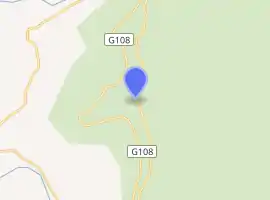Qiqushan Temple
Qiqushan Temple (Chinese: 七曲山大庙; pinyin: Qīqūshān dà miào) or Qiqu mountain Great temple. is a Taoist Temple in Zitong county of Mianyang City, in Sichuan Province, China. The Qiqushan Temple is located on a mountain about a few kilometers away from Zhangtong County, Mianyang City. It has a beautiful surrounding environment and is lined with trees.[1] The ancient building complex of Qiqu Mountain Great Temple integrates the architecture of Yuan, Ming and Qing dynasties[2]. There are 23 halls and attics, with a building area of 5,611 square meters and an area of 13,000 square meters. The ancient buildings cleverly used the topography, The Temple is built on a hill[3], and were not bound by the tradition of parallel central axis, showing a flexible and natural style. The entire temple is exquisitely designed, with stilts on the ridges, sloping corners and volleys. The layers of the pavilions are staggered, the carved beams and the buildings are unique, There are both majestic palace-style buildings in the north and small and exquisite garden-style buildings in the south, fully demonstrating the exquisite skills of ancient Chinese builders.
| Qiqushan Temple 七曲山大庙 | |
|---|---|
 Front View of the Temple | |

| |
| General information | |
| Architectural style | Traditional Chinese Architecture |
| Address | No. 2 Cuiyunlang Road, Zitong County, Mianyang City, Sichuan Province, People's Republic of China |
| Coordinates | 31°41′50″N 105°11′35″E |
| Technical details | |
| Size | 12,000m² - 13,000m² |
History
The large temple was built in Eastern Jin Dynasty. It was originally Named as "Yazi Temple", dedicated to Zhang Yazi In the early Yuan Dynasty, himself Zhang Yazi was named "Emperor Wenchang" and the temple was rebuilt as Wenchang Palace. There are more than 20,000 ancient cypresses next to the temple.
References
- Qiqu Mountain Temple, Trip.com, retrieved February 4, 2021CS1 maint: location (link)
- 文昌文化发祥地梓潼县七曲山大庙“前世今生, Sina Finance, retrieved February 6, 2021
- 七曲山大庙, Phoer.Net, retrieved February 6, 2021